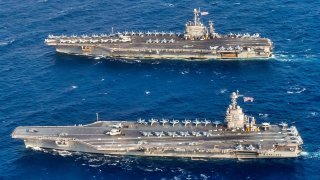China vs. U.S. Navy: Which Fighting Force on the Water Is Stronger?
China now boasts the world's largest navy with 234 operational warships, surpassing the United States. While China has a numerical advantage, the U.S. still holds a qualitative edge, particularly with its fleet of destroyers, guided missile cruisers, and aircraft carriers.
Summary and Key Points: China now boasts the world's largest navy with 234 operational warships, surpassing the United States. While China has a numerical advantage, the U.S. still holds a qualitative edge, particularly with its fleet of destroyers, guided missile cruisers, and aircraft carriers.
-However, China is rapidly closing this gap, launching more destroyers and increasing its overall naval capabilities.
-To offset China's growing fleet, the U.S. may need to rely on regional allies like Japan and South Korea, whose combined naval forces could help balance the scales in the Indo-Pacific region.
China's Growing Navy: Should the U.S. Be Worried?
China’s determined shipbuilding efforts have given them the world’s largest navy. Surpassing the United States’ navy, China now has 234 operational warships. China’s impressive naval buildup hints at grander ambition and suggests obvious advantages.
A recent report by the Center for Strategic and International Studies lays out the difference between the two fleets and notes that “larger fleets won 25 out of 28 historical wars.” Why? Because larger fleets have the ability to “absorb more losses” and “keep fighting.” That could pose a problem for the United States. “In one recent set of wargames, China lost 52 major surface warships compared to between 7 and 20 U.S. equivalents,” CSIS wrote in June. “Even after such catastrophic losses, China still had more surface warships than the United States and was able to continue the naval battle.”
But relative naval quantity is only a part of the analysis – relative quality is also a factor. The United States still maintains a high-quality fleet of warships that the Chinese cannot match. China is working to close the gap.
Comparing the Fleets
The United States has more high-quality, influential vessels than the Chinese – ships such as guided missile cruisers, destroyers, and aircraft carriers. “Destroyers in particular serve as the backbone of any modern fleet,” CSIS wrote, on account of their ability to conduct a variety of missions with speed and range. Right now, the United States possesses 73 destroyers, whereas the Chinese have 42. The American destroyer gap is important, allowing the U.S. “to exert sea control and project power to a greater extent than” the Chinese.
But of course, Beijing is working to match U.S. capabilities. According to CSIS, China’s destroyer fleet grew from 20 vessels in 2003, to 42 in 2023. In the last decade, China launched 23 destroyers to America’s 11.
While the U.S. currently holds an advantage with respect to cruisers and destroyers, China has an advantage in frigates and corvettes – smaller ships that can offer escort and detection value, or perhaps fight in the littoral waters of the Indo-Pacific.
“The U.S. Navy appears to recognize that it might be overinvested in larger cruisers and destroyers: statements by senior U.S. Navy personnel have emphasized the need to rapidly increase frigate production,” CSIS reported. “Both the United States and China are also seeking to develop armed naval surface and underwater systems smaller than China’s manned corvettes.”
Smaller ships are of course quicker to build and can be built in greater numbers. A destroyer or an aircraft carrier can take years to construct.
To offset China’s naval quantity, the U.S. may need to rely on regional partners. Japan operates four cruisers, 34 destroyers, 10 frigates, and four helicopter carriers. South Korea adds another three cruisers, six destroyers, 16 frigates, and five corvettes. If either the Japanese or the South Koreans joined the U.S. forces in a conflict against China, then China would lose its numerical advantage.
Numbers aside, the U.S. should be encouraging its regional partners to participate more actively on principle in defense of the Indo-Pacific. If China continues to expand its navy, and its overall military capabilities, a collective effort will likely be required to balance it.
About the Author: Harrison Kass
Harrison Kass is a defense and national security writer with over 1,000 total pieces on issues involving global affairs. An attorney, pilot, guitarist, and minor pro hockey player, Harrison joined the US Air Force as a Pilot Trainee but was medically discharged. Harrison holds a BA from Lake Forest College, a JD from the University of Oregon, and an MA from New York University. Harrison listens to Dokken.
Image Credit: Creative Commons.

